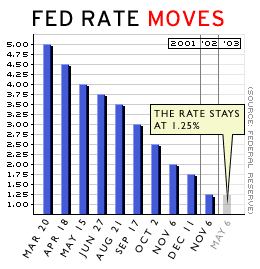NEW YORK (CNN/Money) -
Thanks to some recent, not-so-bad economic data, bond traders suddenly are betting the Federal Reserve may not cut interest rates quite so sharply next week.
The yield on the 10-year Treasury note, for example, has jumped from an intra-day low on Monday of 3.07 percent to 3.35 percent by Wednesday afternoon -- the biggest three-day swing since early March of last year -- a sign that bond investors believe that both short-term and long-term interest rates may not have much lower to go.

But economists are not so sure, saying none of this week's data is likely to change the thinking at the Fed, the nation's central bank.
Fed policy makers are to meet next week to discuss the economy and whether or not they should cut short-term interest rates again to make borrowing cheaper and add more fuel to the economy's fire.
Fed officials' statements after their May policy meeting fueled expectations of a June rate cut, and Treasury bond prices soared, sending yields through the floor, trying to keep up with the expected cut. Treasury prices and yields move in the opposite direction.
Though the Fed and most analysts think the economy will improve in the second half of the year, they've also fretted publicly about persistently low inflation, which could, if it keeps up for very long, turn into deflation, an unstoppable drop in prices that hurts corporate profits and stunts the economy.
But, after reports this week showing signs of strength in manufacturing, new-home building and a key measure of inflation, Treasury bond yields have turned on a dime, in part reflecting the bet that the Fed might not need to be so worried about deflation.
| Related stories
|

|
|
|
|
Though almost nobody expects the Fed to stand pat and make no rate cut at all, bond traders apparently think it's much more likely now that the central bank will cut its target for the federal funds rate, a key overnight bank lending rate, by a quarter percentage point, instead of the more-aggressive half percentage point some economists had expected.
"People overall feel a little bit better about what they're seeing in the economy, so more people are leaning towards a 25-basis-point cut as opposed to 50," said AG Edwards bond analyst Bill Hornbarger. "I think this is justified -- the bond market had gotten a bit ahead of itself." One percentage point equals 100 basis points.
Other economists, however, noted the gaping holes in this week's reports -- much of the strength in consumer prices, for example, was due merely to a jump in hotel-room prices -- and said the Fed expected economic data to strengthen anyway.
The issue is not whether or not the economy will grow, these economists say; the issue is keeping it growing well enough and for long enough that the bottom holds under prices.
"I don't think we've seen anything that will change the Fed's mind," said former Fed economist Wayne Ayers, now chief economist at Fleet Boston Financial. "The Fed has said all along it expects to see a stronger economy. But, even as the economy strengthens, deflation risks are still there; there's still a case to be made for a 50-basis-point cut."
Ayers said a wimpier quarter-point cut might leave investors hanging, waiting for the other shoe -- another quarter-point cut -- to drop.
And a bigger cut might make the markets think the Fed will be more likely to use the unconventional policy weapons in its arsenal, such as buying longer-term Treasury bonds, to push down yields on longer-term debts -- including the 10-year Treasury note, which affects mortgage rates.
"If they cut by 50 basis points, we may also see some movement down in the rest of the yield curve," said Joel Naroff, president and chief economist at Naroff Economic Advisors in Holland, Pa. "If they cut by 25 basis points, I don't think it shows up in the rest of the curve."
The yield curve is the range of interest rates on short-to-long-term bonds.
Of course, the size of the Fed's cut might not be as important to the overall economy as the fact that the Fed has kept rates low for some time -- which they will almost certainly continue to do, no matter how much they cut next week.
"Whether the Fed goes 25 or 50 basis points next week might mean something for managing market psychology, but it doesn't mean nearly as much for the broader economy," said Citigroup economist Steven Wieting. "Their language regarding their future considerations on rates is what should matter."
And if rates will be low for a long time, then it's possible the bond market has overdone itself again, only in the wrong direction. With that in mind, Jim Caron, director of global technical analysis at Merrill Lynch, issued a note Wednesday telling clients to look for buying opportunities in Treasury bonds.
"We are still bullishly biased on U.S. Treasurys," Caron wrote. "Nothing has fundamentally changed. Deflation is still viewed by the Fed as a risk, and we expect the Fed to cut rates 50 basis points."

|

